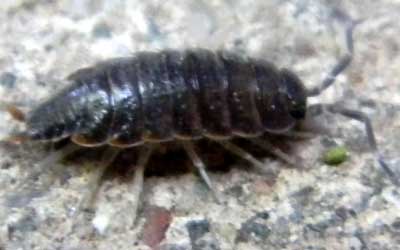Common Rough Woodlouse
Porcellio scaber

This woodlouse is an abundant component of compost heaps maintained in moist, urban habitats of Phoenix, Tucson and Glendale, Arizona. Length is about 12 mm. In the photo the head is to the right and a pair of uropods extend from the posterior at left.
Porcellionidae -- a Woodlouse Family
Sponosored Links
Except in riparian areas most of the Sonoran Desert is too dry for woodlice. Indeed woodlice are crustaceans, relatives to lobsters, crabs and barnicles, so even though they are terrestrial arthropods, they retain their need for rather damp conditions. The Rough Woodlouse is native to Asia and Europe ... its presence in Arizona is due to human commerce and movements which have inadvertantly introduced them. Woodlice feed on dead leaves, old flower petals, and dead insects. Thus they are nature's recyclers and should not pose any issues for gardeners or homeowners. If paper or wood products are kept in a damp condition these arthropods will feed and destroy them; solution is to store them in a dry room instead.
A quick look at a woodlouse should immediately distinguish them as NOT insects, NOT bugs. First notice that a woodlouse does not have the three distinct body parts that characterize insects (head, thorax, abdoment). Next notice that rather than 3 pairs of legs, woodlice have seven pairs.